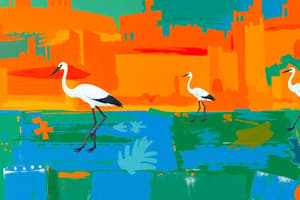Podcast
Questions and Answers
What age-structure diagram characteristic indicates a population growing rapidly?
What age-structure diagram characteristic indicates a population growing rapidly?
- An equal number of prereproductive and reproductive individuals
- More prereproductive individuals than postreproductive individuals
- A higher number of prereproductive and reproductive individuals compared to postreproductive individuals (correct)
- More postreproductive individuals compared to prereproductive individuals
What type of distribution do emperor penguins exhibit in their nesting areas?
What type of distribution do emperor penguins exhibit in their nesting areas?
- Independent distribution
- Clumped distribution
- Random distribution
- Uniform distribution (correct)
What type of distribution is observed in schools of parrot fish near coral reefs?
What type of distribution is observed in schools of parrot fish near coral reefs?
- Random distribution
- Independent distribution
- Clumped distribution (correct)
- Uniform distribution
What does the term 'biotic potential' refer to?
What does the term 'biotic potential' refer to?
Which population has the highest biotic potential?
Which population has the highest biotic potential?
Which of the following populations shows the greatest potential for exponential growth?
Which of the following populations shows the greatest potential for exponential growth?
Which scenario best exemplifies a uniform distribution in a biological context?
Which scenario best exemplifies a uniform distribution in a biological context?
Which factor is most associated with increased reproductive rates in a population?
Which factor is most associated with increased reproductive rates in a population?
Which community has the lowest species diversity?
Which community has the lowest species diversity?
What is the definition of ecological succession?
What is the definition of ecological succession?
Which of the following describes the first pioneer species in secondary succession?
Which of the following describes the first pioneer species in secondary succession?
Which scenario is an example of primary succession?
Which scenario is an example of primary succession?
Which scenario represents a mutualistic relationship?
Which scenario represents a mutualistic relationship?
What characterizes a community with high ecological diversity?
What characterizes a community with high ecological diversity?
What is NOT a characteristic of pioneer species?
What is NOT a characteristic of pioneer species?
Which of the following correctly describes secondary succession?
Which of the following correctly describes secondary succession?
What will be the approximate population of a group of squirrels after 3 years with a 10 percent growth rate each year?
What will be the approximate population of a group of squirrels after 3 years with a 10 percent growth rate each year?
Which statement is not true for both logistic growth and exponential growth?
Which statement is not true for both logistic growth and exponential growth?
What does reaching a stable equilibrium phase indicate about a population?
What does reaching a stable equilibrium phase indicate about a population?
What could explain a wren population consistently stabilizing at around 45 individuals?
What could explain a wren population consistently stabilizing at around 45 individuals?
The decrease in white-footed mouse populations due to food scarcity exemplifies what concept?
The decrease in white-footed mouse populations due to food scarcity exemplifies what concept?
What phenomenon occurs due to infected bees potentially contaminating flowers and spreading disease?
What phenomenon occurs due to infected bees potentially contaminating flowers and spreading disease?
Which factor is an example of density-dependent limitation on a population?
Which factor is an example of density-dependent limitation on a population?
What is a common characteristic of equilibrium species?
What is a common characteristic of equilibrium species?
Different populations living in the same geographical region form a(n)
Different populations living in the same geographical region form a(n)
In the context of caribou and their wolf predators, what type of ecology is being studied?
In the context of caribou and their wolf predators, what type of ecology is being studied?
What type of population growth was observed when butterflies colonized a new island without competition?
What type of population growth was observed when butterflies colonized a new island without competition?
Butterflies and flowers on a barrier island exemplify which ecological concept?
Butterflies and flowers on a barrier island exemplify which ecological concept?
What should a fishing village do to reverse a decreasing population trend?
What should a fishing village do to reverse a decreasing population trend?
Which scenario describes a community?
Which scenario describes a community?
Flashcards
Rapid Population Growth
Rapid Population Growth
A population growing quickly has more individuals in the reproductive stage than the non-reproductive and/or pre-reproductive stage.
Clumped Distribution
Clumped Distribution
Organisms in a clumped distribution are grouped together in certain areas.
Uniform Distribution
Uniform Distribution
Organisms in a uniform distribution are spread out evenly.
Biotic Potential
Biotic Potential
Signup and view all the flashcards
Exponential Growth
Exponential Growth
Signup and view all the flashcards
Reproductive Rate
Reproductive Rate
Signup and view all the flashcards
Age at Maturity
Age at Maturity
Signup and view all the flashcards
Greatest Biotic Potential
Greatest Biotic Potential
Signup and view all the flashcards
Ecosystem
Ecosystem
Signup and view all the flashcards
Least Diverse Community
Least Diverse Community
Signup and view all the flashcards
Ecological Succession
Ecological Succession
Signup and view all the flashcards
Pioneer Species (Secondary Succession)
Pioneer Species (Secondary Succession)
Signup and view all the flashcards
Primary Succession
Primary Succession
Signup and view all the flashcards
Mutualistic Relationship
Mutualistic Relationship
Signup and view all the flashcards
Crab and Coral
Crab and Coral
Signup and view all the flashcards
Secondary Succession
Secondary Succession
Signup and view all the flashcards
Population Growth Rate
Population Growth Rate
Signup and view all the flashcards
Logistic Growth
Logistic Growth
Signup and view all the flashcards
Carrying Capacity
Carrying Capacity
Signup and view all the flashcards
Density-Dependent Factor
Density-Dependent Factor
Signup and view all the flashcards
Density-Independent Factor
Density-Independent Factor
Signup and view all the flashcards
Community
Community
Signup and view all the flashcards
Population
Population
Signup and view all the flashcards
Equilibrium Species
Equilibrium Species
Signup and view all the flashcards
Lag Phase
Lag Phase
Signup and view all the flashcards
Stable Equilibrium Phase
Stable Equilibrium Phase
Signup and view all the flashcards
Population size
Population size
Signup and view all the flashcards
Resource Availability
Resource Availability
Signup and view all the flashcards
Population Growth
Population Growth
Signup and view all the flashcards
Squirrels growth
Squirrels growth
Signup and view all the flashcards
Study Notes
Population Growth and Dynamics
- Age-Structure Diagrams: A population growing rapidly will have a higher number of pre-reproductive and reproductive individuals compared to post-reproductive individuals.
- Spatial Distribution:
- Clumped: Individuals aggregate in certain areas, often due to resources or protection from predators (e.g., schools of fish).
- Uniform: Individuals are evenly spaced, often due to competition for resources (e.g., penguins defending a territory around their nest).
- Random: Individuals are distributed unpredictably (less common in nature).
- Biotic Potential: The maximum rate of population growth under ideal conditions (unlimited resources).
- Exponential Growth: Population growth with a constant rate of increase. Characterized by a steep upward curve.
- Logistic Growth: Population growth that levels off as resources become limited. It shows an S-shaped curve.
- Carrying Capacity: The maximum population size that an environment can sustain (stable equilibrium phase).
- Density-Dependent Factors: Factors whose effect on a population changes depending on the population size (e.g. competition, disease).
- Density-Independent Factors: Factors that affect population size regardless of the population density (e.g. natural disasters).
- Equilibrium Species: Long lifespan, slow to reach sexual maturity, produce few offspring, and invest heavily in parental care.
Community Ecology
- Community: Multiple populations living in the same geographical area.
- Ecosystem: All living (biotic) and non-living (abiotic) factors in an area and their interactions.
- Succession: Orderly change in community composition after a disturbance.
- Primary Succession: Begins on newly formed or barren land (e.g., volcanic rock).
- Secondary Succession: Starts in areas where a community has been removed but the soil remains (e.g., after a fire).
- Mutualistic Relationships: Interactions where both species benefit.
Examples of Interactions
- Predator-Prey Interactions: An example of a feeding interaction (e.g., wolves and caribou).
- Competition: When different species compete for the same resources.
- Parasitism: A relationship where one species benefits at the cost of another (e.g., tapeworms).
Studying That Suits You
Use AI to generate personalized quizzes and flashcards to suit your learning preferences.




